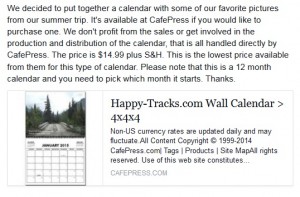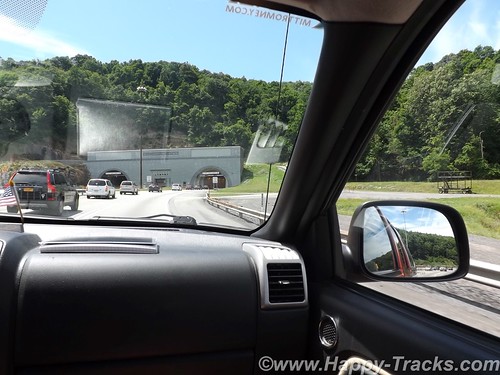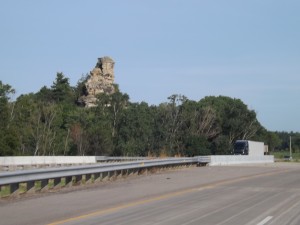We left Medora and headed east on I-94 towards the Missouri River and Bismarck. We called a couple of hotels but found no rooms available without a reservation. Someone recommended the Prairie Knights Resort. Since it was about 50 miles off the highway, we called ahead to check on room availability. They told us they had plenty of rooms so there was no need to make a reservation. Mmmmmkay?

We drove south with the Missouri River to our left through a couple of very small settlements and passed the Ft. Lincoln State Park entrance. It really is 50 miles and there is virtually nothing until you reach the Prairie Knights Casino and Resort. Prairie Knights is a casino and lodge located on the Standing Rock Indian Reservation. It is operated by the Standing Rock Indian Tribe. The casino offers high stakes gaming options, along with 725 slot machines, blackjack, craps, among other games. The lodge portion of the casino consists of 200 guest rooms.

Once we finally get there, we see that they have a landing on the River, the lodge, a restaurant (buffet style), the casino and a small gas station with prices comparable to what we’d seen in Bismarck.

When we go to check in, the clerk asked if we were members of the Prairie Club. Uh, no. Before we get registered, they suggest we go into the casino and register. The registration is free but it knocks $25 off our room rate and gives us $10 to spend in the casino. We are now Prairie club members! We walk around a bit, get some dinner at the buffet and call it a night.

The next morning we head back north towards Mandan and the Ft. Lincoln State Park. Although we didn’t use them, it should be noted that the park has primitive and developed campgrounds and rental cabins near the riverbank. We didn’t go to those areas of the park to check them out. There are also hiking and biking trails.
The visitor center building contains a display that includes exhibits from the Lewis and Clark expedition and from the Mandan Indians who had a village there.

This is where the tour starts for the On-A-Slant Mandan Indian Village. Parts of the village have been the subject of archaeological research and some restoration. Their society was matriarchal with families dwelling in the same lodge including daughters and sons-in-law. The lodge would pass to the eldest daughter on the death of her mother.
The lodges were circular with a fire pit in the center, venting through a hole in the roof which could be covered in hides in times of bad weather. The lodges were also built into the earth with dirt and grass on the outside and over the roof which provided insulation from the temperature extremes. The guide told us of the lodges maintaining 60 degrees even in the coldest parts of winter and they were cool on this hot day when we visited. Generally, the lodge was entered from the side with a partition wall separating the entrance from the main room for weather and defenses. Sleeping pads were around the circumference.

The Mandans were stationary people with language similar to the Sioux. They grew crops and hunted animals while trading with the nomadic tribes. A typical Mandan village consisted of 12 to 100 of these dome-shaped lodges. Their oral traditions indicated they had once occupied the eastern North America.
Their villages were often stockaded for protection and they hosted many of the European explorers, including the Lewis and Clark Expedition and Prussian scientist Prince Maximillian.
In 1750 there were nine large Mandan villages, but recurrent epidemics of smallpox, pertussis (whooping cough), and other diseases introduced through colonization reduced the tribe to two villages by 1800. In 1837 another smallpox epidemic left only 100 to 150 Mandan survivors. Some of these accompanied the Hidatsa to a new settlement near Fort Berthold (northwest of Bismarck) in 1845; others followed later, as did members of the Arikara tribe. The Mandan, Hidatsa, and Arikara eventually became known as the Three Affiliated Tribes (also called the MHA Nation).
In the mid-20th century, the Three Affiliated Tribes lost a considerable portion of their reservation to the waters of Lake Sakakawea, which rose behind the newly built Garrison Dam. With the flooding of the river bottoms, on which had been the best agricultural land, many tribal members shifted from agriculture to ranching or off-reservation pursuits.

In the 1870s, at the same location where the Mandan tribe had established their village, a military post was built in June 1872 by two companies of the 6th U.S. Infantry under Lt. Col. Daniel Huston, Jr., as Fort McKeen, opposite Bismarck, Dakota Territory.

Standing today are two of the watchtowers that overlooked the juncture of the Heart and Missouri Rivers and the town of Bismarck.

The three-company infantry post’s name was changed to Fort Abraham Lincoln on November 19, 1872, and expanded to the south to include a cavalry post accommodating six companies. Among the 78 permanent wooden structures at Fort Lincoln were a post office, telegraph office, barracks for nine companies, seven officer’s quarters, six cavalry stables, a guardhouse, granary, quartermaster storehouse, bakery, hospital, laundress quarters, and log scouts’ quarters. Water was supplied to the fort by hauling it from Missouri River in wagons, while wood was supplied by contract.
By 1873, the 7th Cavalry moved into the fort to ensure the expansion of the Northern Pacific Railway. The first post commander of the expanded fort was Lieutenant Colonel George A. Custer, who held the position until his death in 1876.

Several buildings remain at the post, including Custer’s restored (and furnished) house, the commissary (now the souvenir shop) and some stable and storage buildings.

Custer’s house is open to guided tours. The tour is conducted by a man in period uniform in the role of one of Custer’s aides. The tour is alternately conducted by a woman who was in period dress. The setting is 1875 so the tour does not address the Colonel’s demise at Little Big Horn. Guests are shown through the house as arriving guests for a party to be given that evening by Colonel and “Mrs. Colonel” Custer.

The tour includes a discussion of some additions to the original house that were ordered by Col. Custer following fire damage as well as some entertainments provided to help make the rugged outpost more pleasant for Mrs. Colonel Custer.

One point on the tour is the cellar where the Colonel’s pet wildcat was kept. We also toured the billiards room upstairs which served as something of an officer’s club.

As we returned from our visit to 1875, it was time to load up the truck and continue east to our next night in Fargo, ND. Our knowledge of Fargo was initially limited to the movie starring William H Macy which was somewhat gruesome. We were somewhat disappointed to find that the movie seemed to occupy a large part of the tourist industry with Woodchippers being the local drink at the bar and directions to go take pictures at the chipper in all the tourist literature. Fargo is the largest city in North Dakota at just over 113,000 people. Opposite Fargo and across the Red River of the North is Moorhead, Minnesota. The Fargo area is growing with much construction along both sides of the interstate with much of it devoted to housing, hotels and support of the petroleum industry. Some of the news stories and features of the area talk of the shortage of housing and the boom being fueled by petroleum.
After breakfast the next morning, we made tracks across Minnesota finally stopping in Hudson, Wisconsin just across Lake St. Croix from Minneapolis-St. Paul.


Hudson appears to be a small touristy town which is also a distant bedroom suburb of the twin cities. Our late lunch was in a small (but very friendly) pub style bar where we also called my nephew to see about meeting up with him as we passed near his home north of Chicago. We drove late that night, finally stopping in Loves Park, Illinois for the night.


We did connect with my nephew (whom I hadn’t seen in over 10 years) and met him for breakfast but didn’t get the opportunity to see his family due to other commitments and the short notice we had given them. Our visit was short but it was good to see him.

We continued on and spent the night in Maumee, Ohio.
You can see all of the pictures from this leg of the trip here.
We invite you to continue along with us and hope you enjoy the account!
Don’t forget the trip calendar we put together at CafePress. We think it turned out pretty well and would make a great holiday gift. 
Tag Archives: Minnesota
Summer 2014: Alaska via the AlCan, Maryland to South Dakota
Sunday, July 6th had finally arrived. It was time to begin the big adventure. As it was the third day of the 4th of July holiday weekend, we had thoughts of getting an early start to avoid the leaving Washington traffic. It was probably a good idea but…we pulled out of the driveway at 11:15. It was still morning but hardly qualified as an early start. Thankfully, traffic was not particularly heavy as we headed west on I70 out of Frederick but by the time we reached Breezewood, PA (our usual entry point to the PA Turnpike), the usual weekend stop and go stretched for a couple of miles. It was a good time for lunch. When we came back out, it was apparent that the route onto the turnpike would be a grind but that traffic going west on Hwy 30 was very light. In our first “let’s see where this goes” move, we headed west on 30 and joined up with the turnpike in Bedford.


This part of the trip is one we’ve done several times over the years while Ryan was at college so our focus was on covering miles. We stopped the first night in Fremont IN where we discovered (quite by accident) that hotel nightly rates are sometimes negotiable. Keith hadn’t engaged the filters and said “ouch” when told what the rate was. The desk clerk asked what we had expected to pay and lowered the rate. Hmmm, might come in handy to know that later.
We did manage to get a slightly earlier start on Monday at 10:00 although we were now in Central time zone. We’re still making miles and decide to skip the RV/Motorhome Hall of Fame in Elkhart IN.
Stopping for gas, we start a conversation with a gentleman from Nokesville VA. He seemed a little surprised we knew where Nokesville was. He’s probably my age, maybe a little older. He and his wife were traveling west with his inlaws in a motorhome towing a Jeep. Their trip was to celebrate an 80th birthday for one of the inlaws. Wanderlust doesn’t give up easily, I guess.
Continuing on I90, we manage to make Chicago in time to decide that there are some places where traffic is a constant and that’s not a good thing. While there was likely a better way to get past it, we follow I90 which leads us right through the construction zones downtown. But we did see the Willis Tower (formerly Sears Tower) and the glass-floored viewing platforms (from the ground, not up close and personal).

I90 takes us past Janesville, also known as the hometown of 2012 VP candidate, Rep Paul Ryan. We also pass the state capital, Madison.
North of Madison and just before I90 and I94 part ways, we pass Camp Douglas, the location for Mill Bluff State Park. During WWI, the site was chosen as a permanent training center in part because of the terrain, such as the stone pillars seen in the picture.  During the Cuban Missile Crisis, a black bear caused the nuclear-armed bombers to scramble. You can read more about that here.
During the Cuban Missile Crisis, a black bear caused the nuclear-armed bombers to scramble. You can read more about that here.
We also saw a weather front moving across rather dramatically. The rain never really materialized for us. 
We cross the Mississippi into Minnesota and eventually arrive in Rochester MN, home of the world-renowned Mayo Clinic. We stayed in the suburbs next to the fairgrounds and had a view of the Rochester skyline.

Our hotel was a shuttle stop for multiple shuttles running in to the Clinic each day. While we expected that to be somewhat depressing as folks who are visiting the Clinic are often seriously, even life-threateningly ill but the mood seemed pretty upbeat. Also, our hotel featured a bronze Viking sculpture in the lobby.


The fairgrounds also had a water tower sculpture of a corn cob which reminded us of the Peachoid in Gaffney SC.
An even earlier start on Tuesday morning as we continued west on I90. Farms dotted the landscape and we passed numerous power-generating windmills.

 While it may be commonplace to those in those areas, we were surprised to see the railroad crossing style arms for blocking off the highway during blizzard conditions.
While it may be commonplace to those in those areas, we were surprised to see the railroad crossing style arms for blocking off the highway during blizzard conditions.

Although the temperature was well into the mid 80s, the humidity was low and the continuing breeze kept things pleasant, even bordering on cool.
We crossed into South Dakota on our way to the Corn Palace in Mitchell. The Corn Palace was mentioned to us as a possible stop when I had called the Credit Card company. When she was a child, her family trip across this part of the country included a stop at the Corn Palace which she had specifically remembered from that childhood trip.
The Corn Palace is located in the center of Mitchell (right next to City Hall). Its original purpose was partly to be a tourist attraction decorated with corn cob and husk murals. It also used as an auditorium, a sports venue, the High School Prom and other civic functions.



After a short visit to the Corn Palace (where the murals are being redone for the coming year), we were back onto I90 and headed towards the Missouri River. This crossing marked a first for both of us.

South Dakota marks their rest areas with a rather unique concrete structure recognizing the teepees of the Native Americans.

The landscape seems to stretch forever with a gentle roll as we get closer to the SD Badlands.

We continued towards another tourist attraction, the Wall Drug complex in Wall SD. Wall Drug is and was first a drug store/pharmacy for the people of Wall SD. It was purchased in 1929 and has a become a popular tourist attraction and example of the power of marketing, initiated with giving away free ice water. See more of the history here. It is now a complex of shopping and a landmark from the early days of automotive travel.


After a piece of pie and 5 cents cups of coffee, we stopped in Wall for the night.
You can see all of the pictures from this leg of the trip here.
We invite you to continue along with us and hope you enjoy the account!
